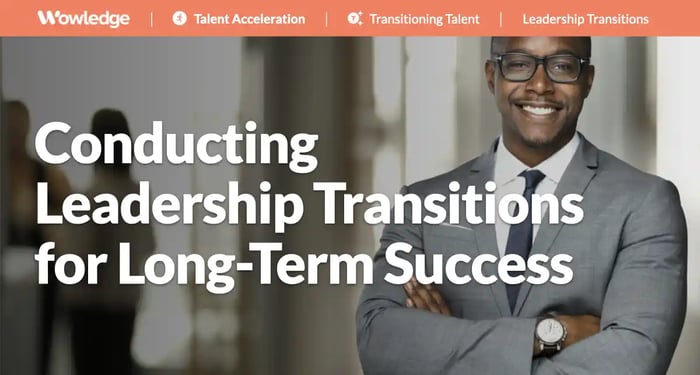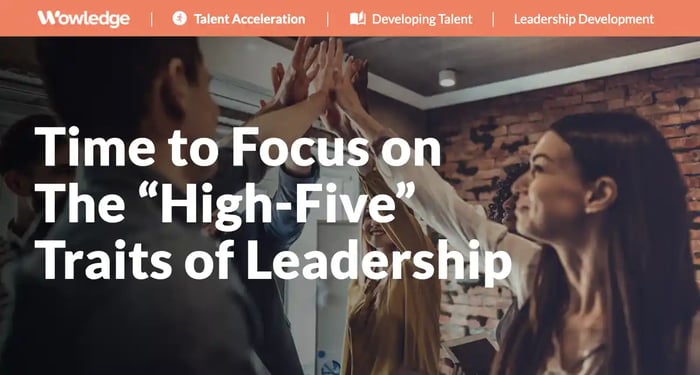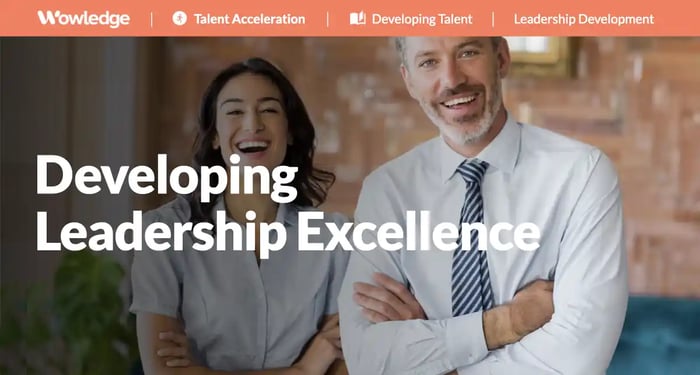Table of Contents
- The leadership transition issue and why it is important
- The value of creating and managing orderly leadership transitions
- The reasons newly placed leaders fail
- Successful leadership transitions require integration across talent management
- Building and executing leadership transitions that stick
- 1. Prepare a robust pool of future candidates
- 2. Select the best-suited candidates
- 3. Prepare the organization for change
- 4. Create a structured onboarding plan
- 5. Develop a detailed organizational assessment, gap analysis, vision, and strategy
- 6. Proactively engage with new peers and direct report team members
- 7. Establish formal development plans for leadership transitions
- Relevant Practices & Tools
- About Wowledge
Given the significant influence and impact executive and senior leadership role holders have on achieving organizational goals and mission success, it is no wonder that companies spend an estimated $37 billion annually to train, develop, and refine their skills. At the same time, with average annual S&P 500 CEO salaries in the tens of millions, and the largest employers spending hundreds of millions on total C-Suite salaries, the resulting performance expectations are extremely high for those individuals. With executive turnover increasing and tenures dropping, the attention being paid to recruiting and ensuring new hire success should be at an all-time high. However, once hired, the oversight of successful leadership transitions is sadly under-supported.
The leadership transition issue and why it is important
Leadership role tenure is, and has always been, something of a high-wire act, with pressures to achieve quarterly and annual financial marks, operational goals, and meet the expectations of Boards, shareholders, and CEO’s. The demands of executive and senior management roles are broad and varied, creating complexities that stretch the skills and challenge the capabilities of even the most experienced and business-savvy leaders. As a result, the burden to meet all those demands simultaneously can lead to leadership turnover (forced or voluntary), and it is happening faster and more frequently across U.S. companies.
For example, the pace of executive turnover has accelerated, with Challenger, Gray, and Christmas reporting that 1,358 CEOs left their posts in Q1-Q2, a 9% increase over the prior year. The length of tenures is also shortening, with the median tenure among S&P 500 CEOs decreasing 20% to only 4.8 years. And consider that when new CEO’s are hired or promoted, they have demonstrated a tendency to replace members of their new team within the first 6-12 months. Exacerbating the issue are new leadership failure rates, with multiple studies from HBR, Deloitte, and McKinsey finding that 30%-60% of executives fail within the first 18-24 months of being promoted or hired.
Regarding the question of leadership transitions, a key finding is that between 25-50% of leadership transitions are considered either ”disappointing” or “a failure” within the first two years in the job. Even more concerning is the observation that poor leadership transitions lead to 20% lower employee engagement levels, and yet worse, a 15% drop in business unit performance. With that said, McKinsey found that well-planned, crafted, and executed leadership transitions correlate to 90% of newly hired or promoted teams meeting their performance goals over the subsequent three (3) years. And the effect of a robust executive onboarding and transition plan has been (unsurprisingly) shown to impact retention, which supports the finding that longer tenured executives (5+ years) outperformed their peers by achieving higher revenue, customer experience, and other critical operational measures. McKinsey reported similar benefits, with successful executive transitions leading to 5% higher revenue and profit levels achieved.

The value of creating and managing orderly leadership transitions
An “orderly” leadership transition process is one that is planned, systematic, and reliable. It is a vital element of maintaining organizational stability, growth, and long-term success. Its goal is to minimize the negative aspects that can inevitably arise from changes in top and senior leadership due to the introduction of different personalities, priorities, expectations, and preferences. By following a well-defined transition plan and process, organizations can minimize disruptions, retain key talent, identify new opportunities, and safeguard the continuity of their mission and values.
Minimizes operational disruptions
A planned transition maintains what is working well and targets improvement opportunities at the organizational level. It engages a qualified successor and supports their transition in a structured manner so that the organization continues its projects and strategies without significant interruptions. A smooth handover prevents productivity loss that can result from uncertainty and confusion.
Preserves institutional knowledge while evolving the culture
The preservation of institutional knowledge, from internal processes to company history, mission, and values, maintains stability. However, cultures and business directions need to evolve and grow to keep pace with market, industry, and workforce shifts. As a result, leadership transitions serve as an opportunity to leverage company strengths while advancing them by expanding collaborative relationships and cultural boundaries. A structured transition, including mentorship and knowledge transfer, ensures that valuable information is passed on rather than lost, while coaching and visionary goal setting can move the needle toward the future.
Retains top talent
A clear succession and transition program signals to all high-potential (HiPo) employees that the organization is invested in their growth and will support their path to success when they move into new roles. Well-executed transition plans include new leader discussions with current and future leaders in their organization about their commitment to continuing development plans, while adapting those to meet planned changes in strategic goals and directions. When engaging their new subordinate leaders in strategy development, refinement, and action planning, the risk of unexpected HiPo and critical role performer turnover can be mitigated.
Builds stakeholder confidence
Having well-considered plans and transition processes communicates organizational readiness for inevitable changes in staffing, and presents a picture of stability and strategic thinking that appeals to investors, customers, Board members, and other stakeholders. It helps preserve a positive brand reputation and supports the stability, continuity, and level of assurance that operations, customers, product, and service quality and reliability will continue, which potential investors, partners, and suitors look for.
Encourages talent management process integration
Orderly leadership transitions rely on a proactive strategy of identifying and preparing future leaders within the organization, while embracing fresh thinking and diverse experiences from external hires. This approach can foster a culture of continuous learning and growth, talent mobility, adaptability, and high performance that creates a more robust talent pipeline.
Alternatively, the risks that come from poorly managed leadership transitions include financial losses due to decreased performance and lost shareholder value, lessened capabilities and expertise from key employee turnover, and strategic misalignment due to failed executive redirection efforts.
The reasons newly placed leaders fail
Part of creating robust and reliable leadership transitions is understanding why so many newly placed individuals fail in their first 12-24 months. A brief review will help establish the importance and value of integrating talent management practices to support leadership transitions. Consider what McKinsey found – that 68% of those new leader failures are due to organizational politics, culture, and people, pointing to the criticality of assimilation, creating connections and support networks, and trusted relationships. DDI reported that 74% of U.S. (and 83% of global) leaders state that they are unprepared for their new roles, pointing to the importance of onboarding and leadership development.
LSA Global has reported similar issues, finding that most leaders are ill-prepared to take on their new role based on the need to manage complex organizational politics and a lack of support once they start the new job. The support that can be provided through coaches, mentors, and formal role onboarding processes can help ease the leadership transitions and increase the likelihood of role success. Further insights from an internal communications perspective point to challenges that many new leaders fail to address or overcome related to transition planning, actions, and behaviors in the first 12-24 months, including:
- Lacking clarity on their initial plans and objectives.
- Failure to listen to and understand employees' and key stakeholders’ needs and requirements.
- An absence of a leadership agenda, vision, and strategy that communicates plans and future opportunities for their team(s).
- A shortage of meaningful actions and impactful changes or improvements.
Successful leadership transitions require integration across talent management
One of the challenges observed in supporting executives during their leadership transitions is the need for, but an all-too-common lack of, well-integrated talent management processes. Consider the executive employment lifecycle, and the many elements of HR programming that have a direct impact on how well-suited, prepared, and supported a newly placed leader is. It starts with the sourcing and selection processes, which identify the blend of skills, experiences, traits, and signs of potential that can be used to create a development plan to fill gaps. The onboarding process guides a new hire through assimilation and enculturation activities designed to get them up to speed and adapt to performing successfully in the new organization.
Succession management is a well-established yet underutilized capability that identifies and prepares future internal (promotion or transfer) role holders for success. Similarly, the leadership development capability prepares current and future executives and senior leaders to meet existing and future challenges. Performance management is a crucial element that defines strategic goal setting, skill and behavior feedback, evaluations based on measurable results, and targeted development plans.
Unfortunately, many organizations fail to effectively link and leverage the capabilities in a coordinated way outside of the use of a common leadership competency or capability framework. In addition, many lack a formal succession planning process (SHRM reported that only 44% have a succession plan in place, but only 21% had a formal plan). In fact, Deloitte research found that only 14% of leaders say that their organization does it effectively, and other research has found that 60% of small-business owners don’t have a succession plan for themselves, let alone for their top executives.

Building and executing leadership transitions that stick
Having well-integrated talent management processes is a foundational requirement, without which effective leadership transitions become unlikely outcomes. Consider the transition into a leadership role as a “journey” or employee lifecycle experience that begins with the application process and culminates in high performance ratings after the first one to three years. The journey is one for the newly-placed leader as well as for the broader organization that requires the attention, planning, and effort of the employee, their bosses, their team, as well as the HR function that creates and oversees the supporting ecosystem. These crucial elements and action steps can, as has been established, make the difference between the company achieving a positive return on its investments and efforts and experiencing a need to replace the new leader within a two-year period.
1. Prepare a robust pool of future candidates
Planning for leadership transitions requires foresight. The key is to execute a succession management process that supports and prepares successors for orderly transitions and high-impact outcomes. This begins with identifying key and operationally critical roles that require a sufficient number of candidates who are ready to ascend or transition into each targeted role. More candidates are better, enough to overcome the inevitable talent losses and failures (e.g., “topping out”) that will occur over time. It means aligning talent development to emerging business directions and associated leadership role skills, capability, and style strength requirements. The process should identify talent gaps and recruit potential successor replacement candidates from outside the organization as needed.
2. Select the best-suited candidates
Leadership transitions should be standard for all new senior leaders – whether newly hired, promoted, or transferred from inside the organization. While the likelihood of failure is lower with internal candidates who are already better acclimated and enculturated, an external hire might be preferred for their ability to bring new ideas and perspectives to the organization. Either way, a well-prepared hire should have the proper blend of skills, experiences, vision, and leadership presence and capabilities. The selection process should leverage validated psychometric assessments that evaluate their interpersonal and social adaptability, measuring traits such as emotional intelligence, leadership style and potential, integrity, and collaboration.
3. Prepare the organization for change
One often-missed element of a successful leadership transition borrows from strategic change management strategies, which is communicating the need, purpose, and value to be achieved with a new leader. The key is to prepare the organizational culture for new leadership, to give a head start to the inevitable changes that are coming. The goal is to start the process of making the environment as accepting and open to the future addition as possible, starting with leadership peer group members, then the future leader’s direct report team, and downward throughout that organizational structure. The key messages should include (without disparaging or otherwise slighting the previous job holder):
- Why new leadership is forthcoming or needed.
- What key stakeholders (customers, suppliers, the Board, or CEO) hope to see.
- What top leadership anticipates retaining and continuing.
- Opportunities that a new hire brings, such as fresh perspectives, strategies, processes.
- The need to prepare for their own transition and adaptation with open minds, hearts.
4. Create a structured onboarding plan
Best practice calls for a comprehensive onboarding plan that defines goals, activities, and timelines to be conducted and met in a way that leads to the new leader’s cultural indoctrination, work methods and process assimilation, relationship and network building, and strategic direction awareness and adaptation. A checklist approach should be developed for the first 12 months that defines the resources to be accessed, crucial people to meet and build trusted relationships with, timeframes for completing and submitting strategic and communication plans and content, and cadences for meetings with assigned supervisory, peer, and external coaches and mentors.
5. Develop a detailed organizational assessment, gap analysis, vision, and strategy
Building off of an onboarding review of strategic plans, financial and operational metrics, analyses, and meetings with stakeholders, direct reports, and employees, a fair and objective assessment of the new organization should be prepared and documented. It should include strengths, successes, and opportunities for growth and change, as well as an initial assessment of successes and capabilities to be exploited and sustained, enhanced, and gaps in operational performance and outcomes to be addressed. A vision and strategy should be conceived and documented, and reviewed with the supervising executive, and any mentors and/or coaches.
6. Proactively engage with new peers and direct report team members
The successful transition is largely driven by the confidence, trust, and comfort earned and returned by influential others – especially one’s management, peers, direct reports, and critical stakeholders (e.g., Board of Directors, key customers). Those relationships are built over time, and many of them will not come “knocking” on the new leader’s door without invitation. As a result, an assertive approach to creating opportunities to interact, establish rapport, and build trust is essential. The new leaders should be guided to ask questions, use active listening, and respond thoughtfully without judgment on a continuing basis. The insights from those discussions should be used to generate plans and initiatives that address an action list prioritized by strategic business alignment, operational impact, and improvement, and stakeholder outcomes.
The key outcome is to build a network of trusted relationships, including mentors and coaches, who can provide insights, feedback, and guidance as to the priority needs and opportunities for the new organization. It also requires an open-eyed assessment of key influencers and detractors whose support will be needed and called upon as strategy implementations are planned and executed.
7. Establish formal development plans for leadership transitions
From the first day, new leaders need to understand not only what needs to be achieved and how it will be accomplished, but also how they need to “show up” or present themselves most effectively in the context of the new organization and role. Accurate self-insight is a trait that does not come naturally to many people, and its impact on the performance of a leader with dozens, hundreds, thousands, or even more followers is substantial. The use of validated assessments (e.g., leadership or communications styles and strengths) can be used to coach and develop plans of action to leverage strengths and overcome weaknesses. Those insights can become one basis for a development plan designed to build new awareness and skills needed for strategic success, stakeholder relationship management, and managing inevitable conflicts, disagreements, and challenges that will occur within their teams.
Relevant Practices & Tools
Core Executive Transition Practices to Prioritize Strategic Goals for the Future. >
Over the past decade, much of the workforce has evolved into a more fluid, “gig-like” environment, taking advantage of internal and external opportunity marketplaces... more »
Creating a Personal Board of Directors to Serve as Mentors for Ongoing Support and Direction. >
As an executive progresses through their career, it becomes more important to maintain a personal board of directors... more »
Evaluating Stakeholders to Understand Supporters and Blockers for Critical Initiatives. >
It’s well known that no matter how effective an executive is at their job, if they don’t have the support of other stakeholders, they will be limited from the start... more »
Identifying and Calibrating Successors and HIPOs for Each Role Through Structured and Standardized Assessment Sessions. >
Naming potential successors for executive and critical roles is a collaboration between leaders that requires thought, preparation, and discussions... more »
The 180-Day Plan Tool: Define Key Milestones and Actions Required to be Successful During an Executive Transition and Beyond. >
A template that allows mapping high-level organizational milestones, as well as key milestones for an executive’s biggest priorities by month for the next 180 days... more »
About Wowledge
Wowledge is the implementation-first platform designed for lean HR teams and consultants who need to design and scale strategic HR programs efficiently—without starting from scratch.
Our members gain access to continuously updated best practices, step-by-step guidance, expert-built tools, and customizable templates—all structured to accelerate the development and implementation of key HR programs.
Recognizing that every organization operates at different levels of sophistication, Wowledge’s scalable system of best practices follows a stage-based approach—Core, Advanced, and Emerging—ensuring HR professionals can implement solutions tailored to their organization’s unique needs and goals.
Your Shortcut to Amplifying HR Impact!
Get started for FREE! Learn more.










